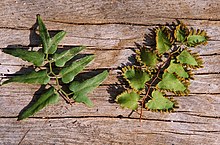
Lygodium is a genus of about 40 species of ferns, native to tropical regions across the world, with a few temperate species in eastern Asia and eastern North America. It is the sole genus in the family Lygodiaceae in the Pteridophyte Phylogeny Group classification of 2016. Alternatively, the genus may be placed as the only genus in the subfamily Lygodioideae of a more broadly defined family Schizaeaceae, the family placement used in Plants of the World Online as of November 2019.

Sceptridium is a genus of seedless vascular plants in the family Ophioglossaceae, closely allied to the genus Botrychium. It is also closely related to the genus Botrypus. Sceptridium species are commonly called the grape-ferns.

Ampelopsis, commonly known as peppervine or porcelainberry, is a genus of climbing shrubs, in the grape family Vitaceae. The name is derived from the Ancient Greek: ἅμπελος (ampelos), which means "vine". The genus was named in 1803. It is disjunctly distributed in eastern Asia and eastern North America extending to Mexico. Ampelopsis is primarily found in mountainous regions in temperate zones with some species in montane forests at mid-altitudes in subtropical to tropical regions. Ampelopsis glandulosa is a popular garden plant and an invasive weed.

Sesbania is a genus of flowering plants in the pea family, Fabaceae, and the only genus found in tribe Sesbanieae. Riverhemp is a common name for plants in this genus. Notable species include the rattlebox, spiny sesbania, and Sesbania sesban, which is used in cooking. Plants of this genus, some of which are aquatic, can be used in alley cropping to increase the soil's nitrogen content. The species of rhizobia responsible for nitrogen fixation in Sesbania rostrata is Azorhizobium caulinodans.

The Arthur R. Marshall Loxahatchee National Wildlife Refuge is a 145,188-acre (587.55 km2) wildlife sanctuary is located west of Boynton Beach, in Palm Beach County, Florida. It is also known as Water Conservation Area 1 (WCA-1). It includes the most northern remnant of the historic Everglades wetland ecosystem.

Parkinsonia, also Cercidium, is a genus of flowering plants in the pea family, Fabaceae. It contains about 12 species that are native to semi-desert regions of Africa and the Americas. The name of the genus honors English apothecary and botanist John Parkinson (1567–1650).
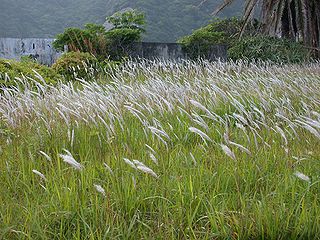
Imperata cylindrica is a species of perennial rhizomatous grass native to tropical and subtropical Asia, Micronesia, Melanesia, Australia, Africa, and Southern Europe. It has also been introduced to Latin America, the Caribbean, and the Southeastern United States. It is a highly flammable pyrophyte, and can spread rapidly by colonizing disturbed areas and encouraging more frequent wildfires.

Schinus terebinthifolia is a species of flowering plant in the cashew family, Anacardiaceae, that is native to subtropical and tropical South America. Common names include Brazilian peppertree, aroeira, rose pepper, broadleaved pepper tree, wilelaiki, Christmasberry tree and Florida holly. The species name has been very commonly misspelled as ‘terebinthifolius’.

Cenchrus is a widespread genus of plants in the grass family. Its species are native to many countries in Asia, Africa, Australia, the Americas, and various oceanic islands.

Parkinsonia microphylla, the yellow paloverde, foothill paloverde or little-leaved palo verde; syn. Cercidium microphyllum), is a species of palo verde.
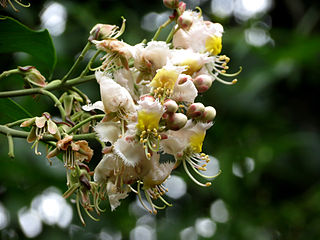
Hiptage benghalensis, often simply called hiptage, is a perennial, evergreen liana native to India, Southeast Asia, Taiwan, and the Philippines. Its habitat is variable and prefers climates ranging from warm temperate to tropical. In Hawaii, where H. benghalensis is considered a weed, as it is in Australia, Mauritius and Réunion, it grows from sea level to 1,000 m (3,281 ft). H. benghalensis is cultivated for its white-pink scented flowers.

Pilea microphylla also known as angeloweed, artillery plant, joypowder plant or brilhantina is an annual plant native to Florida, Mexico, the West Indies, and tropical Central and Southern America. In the southern part of México, specifically Campeche and Mérida, the local name is Frescura. The plant belongs to the family Urticaceae. It has light green, almost succulent, stems and tiny 1/8" leaves which contribute to its other nickname, "Artillery Fern", though it is not related to ferns. It is grown as a ground cover in many areas.
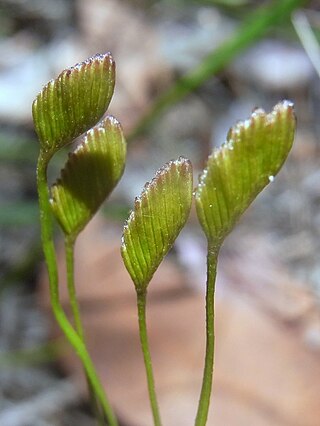
Schizaeaceae is a family of ferns in the order Schizaeales. In the Pteridophyte Phylogeny Group classification of 2016, it includes only two genera. Alternatively, two families kept separate in PPG I, Lygodiaceae and Anemiaceae, may be included in Schizaeaceae so that the family has four genera. In this approach, the Schizaeaceae of PPG I is treated as the subfamily Schizaeoideae.

Lygodium palmatum is the only species of its genus native to North America. Unlike most species in the genus, this one, called the American climbing fern, Hartford fern, or Alice's fern, is extremely hardy in temperate zones.

Aframomum corrorima is a species of flowering plant in the ginger family, Zingiberaceae. It's a herbaceous perennial that produces leafy stems 1–2 meters tall from rhizomatous roots. The alternately-arranged leaves are dark green, 10–30 cm long and 2.5–6 cm across, elliptical to oblong in shape. Pink flowers are borne near the ground and give way to red, fleshy fruits containing shiny brown seeds, which are typically 3–5 mm in diameter.
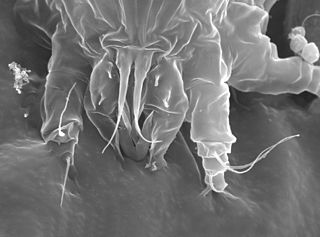
Floracarus perrepae is a species of herbivorous mite belonging to the family Eriophyidae. It is native to Australia (Queensland), China and New Caledonia. As it is known to attack and eat the invasive fern species Lygodium microphyllum, it is being considered for use as a biological pest control agent in Florida.

Tamarix chinensis is a species of tamarisk known by the common names five-stamen tamarisk and Chinese tamarisk or saltcedar. It is native to China and Korea, and it is known in many other parts of the world as an introduced species and sometimes an invasive noxious weed. It easily inhabits moist habitat with saline soils. It may grow as a tree with a single trunk or as a shrub with several spreading erect branches reaching 6 metres or more in maximum height. It has been known to reach 12 metres. It has reddish, brown, or black bark. The small, multibranched twigs are covered in small lance-shaped, scale-like leaves which are no more than about 3 mm long. The inflorescence is a dense raceme of flowers a few cm long. Each fragrant flower has five petals which are usually pink but range from white to red.

Austromusotima camptozonale, the climbing maidhair pyralid moth, is a moth of the family Crambidae. It is native to Australia, but attempts have been made to introduce it to southern Florida as a biological control agent for Old World climbing fern.

Lygodium japonicum is a species of fern that is known by the common names vine-like fern and Japanese climbing fern. It is native to eastern Asia, including Taiwan, Japan, Korea, southeastern Asia, and India, and eastern Australia. The fern is present in the southeastern United States and Puerto Rico as an introduced species.
Actinostachys pennula, the ray spiked fern or tropical curly-grass, is a fern native mainly to Southern Florida and is an endangered plant species.
